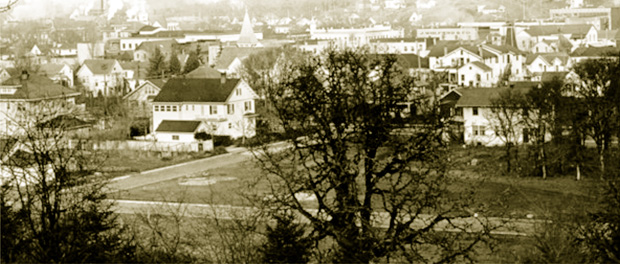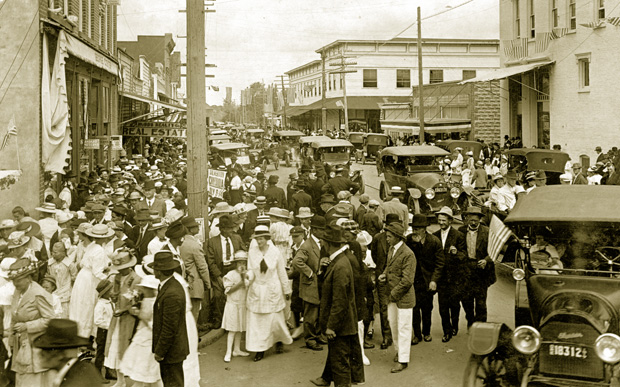(Originally Published in the October, 2014 SCHS Newsletter)
The first day of Chautauqua is here! Or more accurately, the first day of Chautauqua week is here… The date was Sunday, July 9, 1916 and the excitement in the small community had been building ever since the first Chautauqua gathering ever to be held in Silverton was announced. Along with this excitement, there had been no small amount of trepidation that the event, to be held July 9-14, 1916, might not be a success. Numerous local citizens had put up a monetary guarantee to the company providing the Chautauqua to ensure a minimum number of ticket sales.
Circuit Chautauqua was essentially the third iteration of the Chautauqua movement, named for Lake Chautauqua in upstate New York. Organized in the 1870s, Chautauqua was a predominantly American cultural tradition that emphasized the general advancement of adult education, initially emphasizing religious training; ultimately evolving into much broader areas of education, entertainment and enlightenment. The first sessions were held at the Chautauqua Institute on the shores of Lake Chautauqua in New York State. Later, many communities throughout the United States eventually established their own permanent Chautauqua organizations. As the expenses for these organizations increased, “circuit Chautauqua” was developed in 1904 as a sort of traveling road show, providing professionally developed programs at a reasonable cost to communities along the circuit route.
The Silverton Chautauqua was managed by the Ellison-White Chautauqua Bureau, based in Portland, Oregon. One of the largest organizations of its kind, it provided organizational and logistical support for the Silverton Chautauqua. These activities included advance publicity, advertising, and setting up the large circus type tent in which the programs would be held. Perhaps most importantly, Ellison-White hired the Chautauqua “talent”, the various lecturers and other performers who would provide the entertainment.
Local resident F.E Callister was the general chairman in charge of planning for Chautauqua week. Other local citizens active on various committees included Reber Allen, George Steelhammer, Dr. C.W. Keene, Percy Brown, George Hubbs, and Julius Alm.

The first Chautauqua tent was set up in the relatively new Parkside Addition on undeveloped lots owned by prominent local citizen Eva Coolidge, by then President of Coolidge and McClaine Bank, (above). These lots were situated at the north end of the block currently bordered by Coolidge Street, Apple Avenue, and Jerome Street. The July 14, 1916 edition of the Silverton Appeal reported “The Chautauqua tents were placed on Miss Coolidges’ (sic) lots on Coolidge Street. It is ideal (sic) spot.”
As Chautauqua approached, the July 7, 1916 Silverton Appeal devoted almost the entire front page to Chautauqua week, displaying large graphics at the top and bottom of the page. The schedule of events was displayed prominently in the center of the page, complete with a typesetting error that listed the year as 1816 instead of 1916.
The arrival of Chautauqua in Silverton was highly anticipated. Highlighting the support of the local business community, the Daily Capital Journal in Salem reported “The large tent (is) being filled both afternoon and evening, with the greater number of the business houses closed during each afternoon throughout Chautauqua week.”
A typical day during Chautauqua week involved morning, afternoon, and evening sessions. Each 9:00am morning session involved the “Junior Chautauqua”, children performing “Organizing King Arthur’s Court.” The afternoon would showcase both a musical act and a lecture beginning at 2:30pm and 3:00pm respectively. The same would occur during the evening sessions, beginning at 7:30pm and 8:15pm. Patrons could purchase admittance a´ la carte for the morning, afternoon, and evening gatherings. Prices ranged from 15¢ for the Children’s Chautauqua morning sessions to a high of 75¢, with the majority costing 35¢ or 50¢, for the afternoon and evening events. People could also purchase season tickets that would allow admittance to any performance on any of the six days of Chautauqua week.
Lecturers, also known as “platform speakers”, included Victor Murdock, Ernest J. Silas, and Arthur A. Franzke. Musical acts included Witepakie’s Hungarian Orchestra, mezzo-contralto Madam Fay Morvilius, The Gullotta Trio, and the Boston Lyric Opera Company.
S. Platt Jones, humorist and impressionist, performed on Sunday night. The July 14, 1916 Silverton Appeal reported “His jokes were supremely funny and his impersonations of characters great … But underneath the jokes and permeating everything the humorist said, was a vein of helpful uplifting and moral sentiment. He was greatly enjoyed.” The Appeal was not always complimentary toward the per-formers. It also reported “Tuesday afternoon and evening the Lyric Operatic Company presented their musical program. This was considered by many the least attractive of any.”
The first Silverton Chautauqua concluded on Friday night, July 14, 1916. During the closing events Chautauqua Superintendent C. A. Matteson offered his appreciation to the citizens of Silverton for their warm welcome of the Chautauqua entertainers. According to the July 21, 1916 issue of the Silverton Appeal “He specially mentioned Miss Coolidge who had given freeuse (sic) of the land for the tent; the Silverton Lumber Co., who donated lumber; the P.R.L. & P. Co., who gave free lights, Mr. Hyett for the delightful auto rides…”
As it turned out, the original guarantors of the event need not have worried as Chautauqua week was a complete success. The Appeal reported in headlines: “Obligations All Met”, “Guarantors of Chautauqua Come Through Without a Scratch.” and “Money Over.” The article announced that a con-tract had been signed to bring Chautauqua to Silverton again the following summer, as would occur for several subsequent years. As the Great Depression approached, the Chautauqua movement petered out during the 1920s due partly to the influence of the new medium of radio, but that’s a story for another time.

